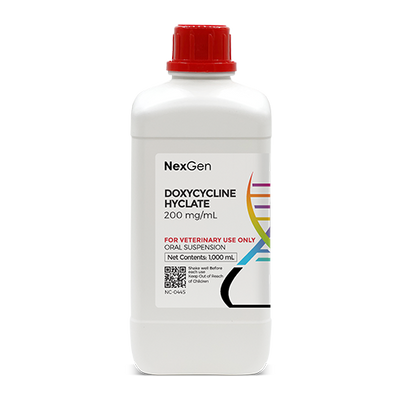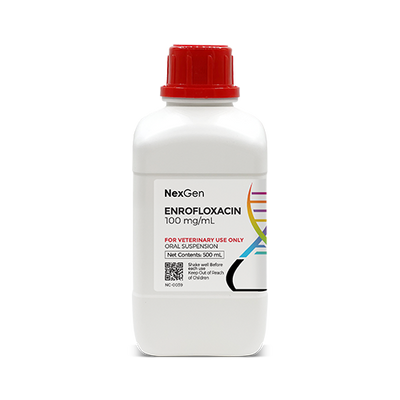
Doxycycline Hyclate 100 mg/mL, Oral Suspension, 500mL
Login for pricing
- Brand
- Mixlab
- SKU:
- NC-0351
- Product Type:
- Suspension
- Size:
- 500ml
- Administration:
- Oral
Most adult horses are resistant to bacterial disease, while foals and geriatric horses are at greater risk of developing bacterial disease due to the fact that their immune systems are not as robust as those of younger horses.1 Bacterial infections are also more common in horses that travel or frequent stables where many horses congregate.
More often than not, a horse’s immune system is able to overcome bacterial intrusions without the horse developing clinical signs of sickness. In a majority of cases, bacterial disease occurs when the horse’s immune system has been weakened and bacteria are able to replicate and spread throughout the horse’s body.
When a horse shows clinical signs of bacterial disease, the source of bacteria is usually often contaminated water, food or feces that are subsequently ingested. In the case of some bacterial infections (e.g., skin, respiratory), the causative agent may be present in the environment.
Common Bacterial Diseases of the Horse
Some of the most common bacterial diseases of horses include:
Anthrax (Bacillus anthracis) is a very serious infection that can kill horses rapidly. The bacterium that causes anthrax forms spores; this allows it to survive for extended periods of time outside an animal’s body. Infection can occur from a horse ingesting or inhaling the spores, or through a break in the horse’s skin. An early sign of infection in horses is colic, with a high fever, difficulty breathing and edema occurring later.
Botulism (Clostridium botulinum) is caused by the toxin produced by the C. botulinum bacterium. It can occur in both foals and adult horses, and is sometimes called “shaker foal syndrome.”2 Horses become infected by eating feed contaminated with the toxin, eating the bacterial spores or having a wound become infected with the bacteria. The chief symptom of infection is weakness or paralysis, and botulism can cause death if the muscles that control breathing are compromised.
Cryptosporidiosis (Cryptosporidium spp.) is a parasitic disease which is usually spread via the ingestion of infected feces. Horses infected with cryptosporidium often do not evidence signs of illness, although pre-weaned foals appear to be more likely to experience diarrhea than weanlings, yearlings and older horses.
Lymphangitis is an inflammation of the horse’s lymphatic channels, and can be caused by infectious or noninfectious agents, which can include bacteria, mycobacteria, viruses, fungi, and parasites.2 Infection can occur through wounds in the skin or contact with contaminated grooming equipment or tack. Symptoms include small lumps or swelling, sores on the fetlock and painful inflammation.
Potomac horse fever (Neorickettsia risticii) causes fever, mild colic and diarrhea. It can affect horses of all ages and can cause pregnant mares to miscarry. The N. risticii bacterium has been found in parasites that live in some insects and snails, and horses can become infected when they accidentally eat aquatic insects that contain the infected flukes.
Salmonella (Salmonella spp.) can cause diarrhea in horses, and younger horses are more at risk of infection. More severe cases of salmonella infection can lead to inflammation of the intestines or even death. Horses are most often infected by ingesting contaminated feed or water.
Strangles (Streptococcus equi) is a highly contagious disease of horses. Symptoms include fever, abscesses in the upper respiratory tract, discharge of mucus from the nose and swollen lymph nodes. A horse may also have difficulty swallowing and may breathe noisily or heavily.
Tetanus (Clostridium tetani) is caused by a toxin produced by the C. tetani bacterium; this blocks nerve signals, causing severe contraction of muscles and extreme responses to stimuli. Symptoms may include stiffness of the muscles of the jaw, neck and hind limbs. The C. tetani bacterium lives in soil, so a horse can become infected through puncture wounds.
Oral Doxycycline Hyclate for Horses
Doxycycline hyclate is broad-spectrum antibiotic composed of a semi-synthetic tetracycline derived from oxytetracycline. It is commonly used in small animals to treat a variety of infections caused by several different microorganisms, including Borrelia spp, Leptospira spp, Rickettsia spp, Anaplasma spp, Ehrlichia spp, Chlamydia spp, Mycoplasma spp, Bartonella spp, and Bordetella spp. In horses, it is often used for treating bacterial infections, including Potomac Horse Fever and Lyme disease.3
There are currently no FDA-approved veterinary doxycycline products available, but the drug’s pharmacokinetic parameters as compared with either tetracycline or oxytetracycline make it a preferable choice to use in animals when a tetracycline is indicated, particularly in azotemic patients.3
Where to buy Doxycycline Hyclate
Doxycycline is available in the U.S. through pharmaceutical manufacturers and through veterinary custom compounding companies.
Please consult your veterinarian prior to beginning any treatment regimen.
FOR RX ONLY: A valid prescription from a licensed veterinarian is required for dispensing this medication.
1Panchaud Y, Gerber V, Rossano A, Perreten V. Bacterial infections in horses: a retrospective study at the University Equine Clinic of Bern. Schweiz Arch Tierheilkd. 2010 Apr;152(4):176-82. doi: 10.1024/0036-7281/a000040. PMID: 20361396.
3cdc.gov.




















